The OnePlus 2 Review
by Brandon Chester on December 14, 2015 8:00 AM EST- Posted in
- Smartphones
- Mobile
- OnePlus
- OnePlus 2
System Performance
The OnePlus 2 uses Qualcomm's Snapdragon 810 SoC. At this point we've seen Snapdragon 810 in a number of devices and have an idea of what to expect. That being said, we've seen that performance can vary based on the device it's implemented in due to cooling and other factors like the CPU governor. On top of that, in many situations a device's performance is heavily dependent on the quality of its software in addition to the processing power of its SoC. For those reasons it's important to run the OnePlus 2 through our standard suite of web and native benchmarks in order to gauge its performance relative to other Snapdragon 810 smartphones, and the rest of the smartphone market as a whole.
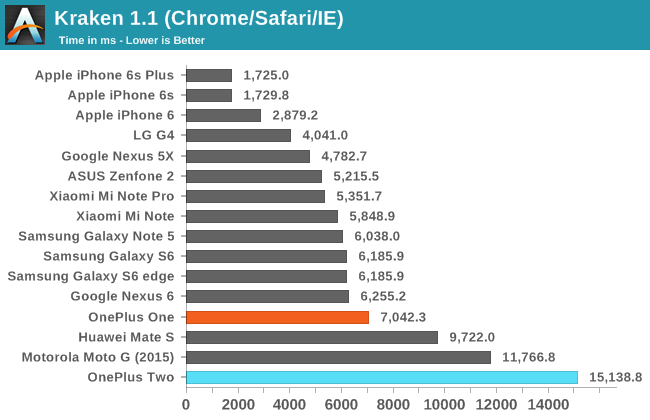
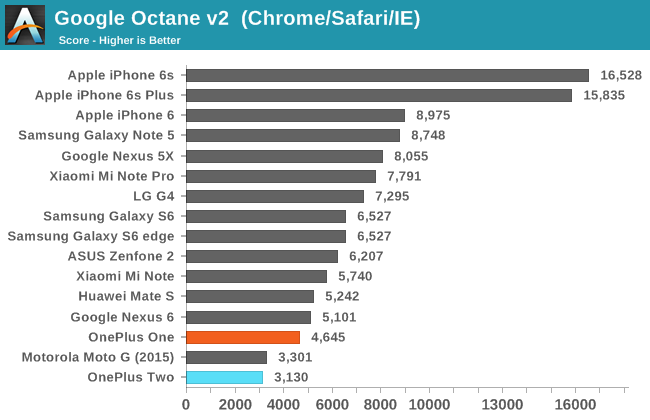
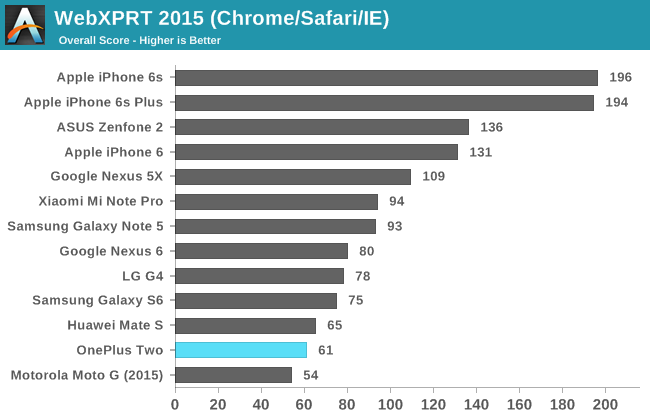
When I saw the web performance results from the OnePlus 2 I assumed there had been some sort of error, so I decided to completely reset the phone and run them again. Unfortunately, these results are not erroneous. You may have noticed that they bear a remarkable similarity to the results from the Moto G (2015). After looking at the CPU activity during web browsing I realized that this isn't really surprising, because the OnePlus 2 simply does not use any of its Cortex A57 cores during web browsing. This means that you're really getting a quad core Cortex A53 CPU, and with JavaScript being heavily bound by the performance of a single core it's no wonder that the results are close to those of the Moto G (2015) which uses a quad core 1.4GHz Cortex A53 CPU.
I don't really want to retread the Snapdragon 808 and 810 topic, but it's really worth noting that this is the worst implementation of the SoC I've seen to date. It's worth noting that this doesn't say anything about the length of time the A57 cores can run for when they do actually get used, but it shows that they're not getting used in circumstances where they should be: bursty workloads where the full performance of the CPU is needed for a short period of time to improve the user experience. It's especially concerning because OnePlus was making a great deal of noise about their work to manage thermals on Snapdragon 810. I personally don't think simply not using the big cores on an SoC constitutes properly managing its temperature, and the poor JavaScript performance truly does make browsing the web feel like using a slower and much less expensive phone like the Moto G.
Update:
There has been some concern online that these web browsing results may be inaccurate. The evidence to the contrary has been in the form of results from other reviews, results using other ROMs or kernels, or using other web browsers. To clarify, these scores were achieved using the latest version of Oxygen OS for the OnePlus 2, which is 2.1.2, in the latest version of Google Chrome. The reason for the scores is that OnePlus is specifically detecting whether or not Chrome is the active application, and if that is the case they unplug all of the Cortex A57 cores, regardless of the load being placed by both Chrome and background applications. Below I have embedded a video that demonstrates this behavior.
In this circumstance I launched a CPU load virus with 4 threads in order to cause Snapdragon 810's Cortex A57 cores to reach peak clocks. CPU4 through CPU7 represent the Cortex A57 cores, while CPU0 and CPU1 are two of the Cortex A53 cores, with the other two tracking at the same frequencies but not being shown on screen in order to accommodate my fingers. You can obviously see the clocks of the A57 cores dropping as heat becomes an issue, but that's not really the focus here. What is the focus is how all four cores shut off the moment Chrome is opened. This is clear evidence that OnePlus has hard coded this behavior. Whether or not it was introduced in more recent releases of Oxygen OS is hard to say, but given that users report achieving greater scores a few months ago this is very possible. It's also important to note that this behavior only affects Chrome, and results from the Chrome Dev or Chrome Beta channels are unaffected.
While the OnePlus Two is technically capable of faster browser performance, the performance users will actually see using the only browser included on the device is reflected accurately in the results we have published, and not at all accurately by any results other users are achieving with different kernels that modify the CPU behavior, or different releases of Chrome that aren't detected by OnePlus's software. With that in mind, I see no reason to alter the results that have been published, as they accurately characterize the JavaScript performance that most OnePlus Two users will experience.
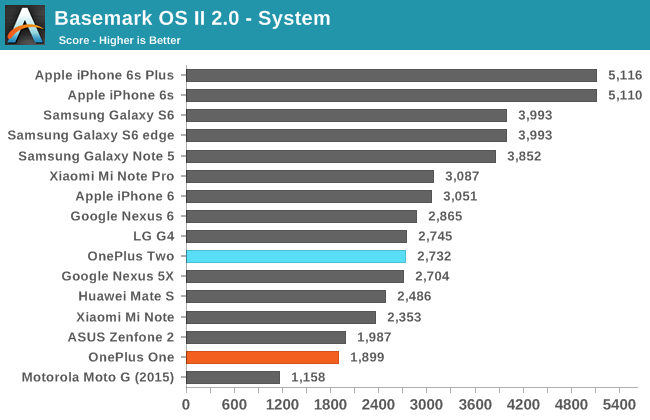
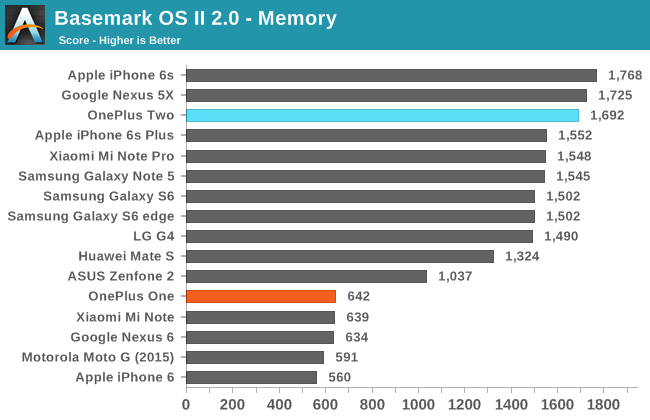
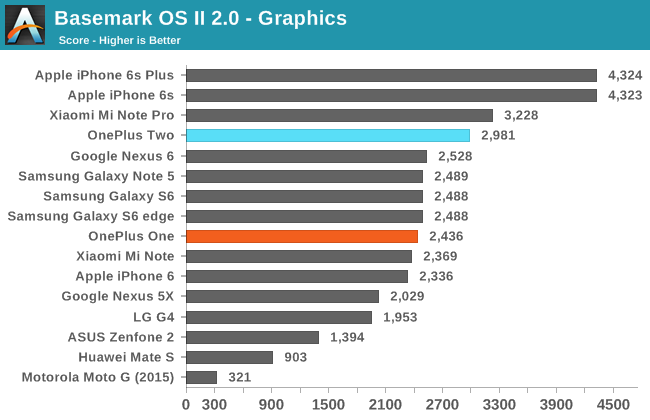
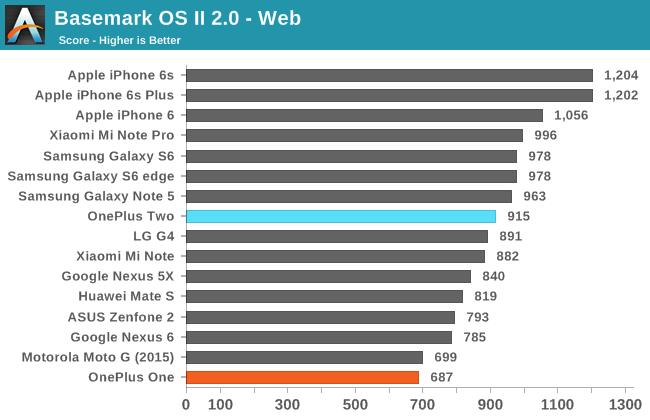
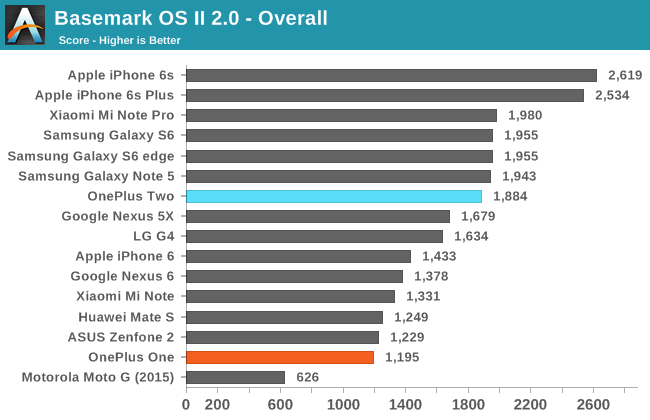
BaseMark OS II is a case where the Cortex A57 cores on the OnePlus 2 actually see some use, which translates into higher relative scores than what was achieved in browser testing. Improved scores in the graphics and NAND memory tests help make the overall score significantly higher than the OnePlus One. It's worth noting that the use of the Cortex A57 cores means that the BaseMark results may not be exactly representative of how the phone will actually perform in general use. For example, in this case the Cortex A57 cores are in use during the web test, while in general they never get used at all during web browsing, and in more intensive situations the best case is that there are two A57 cores in use at some frequency and the other two are shut off.
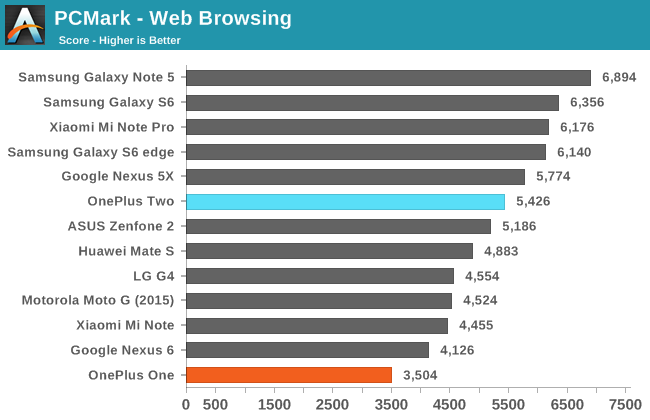
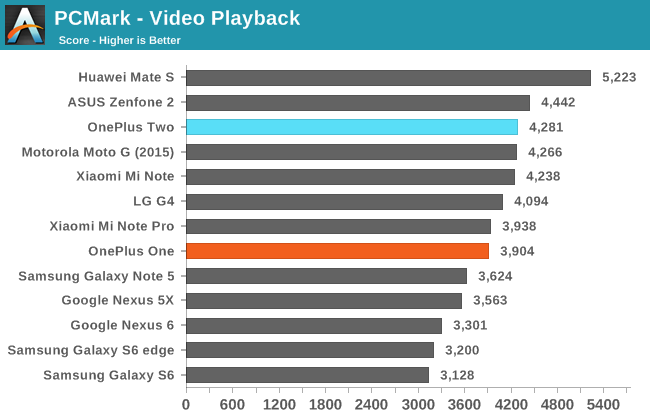
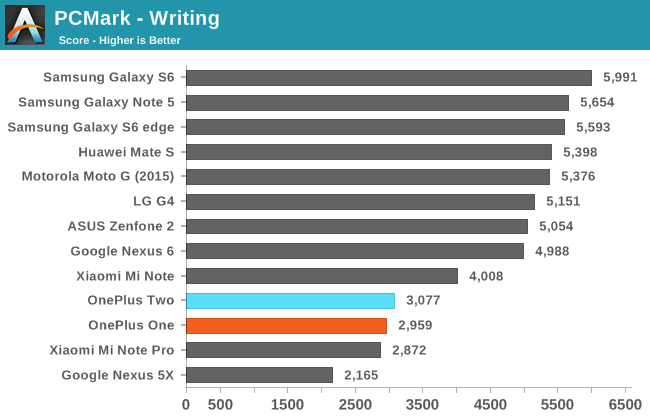
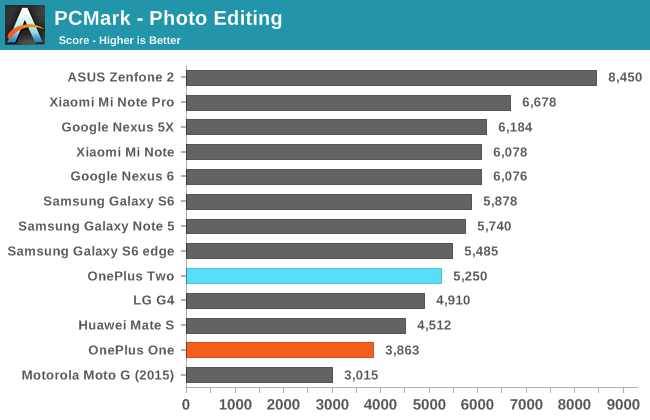
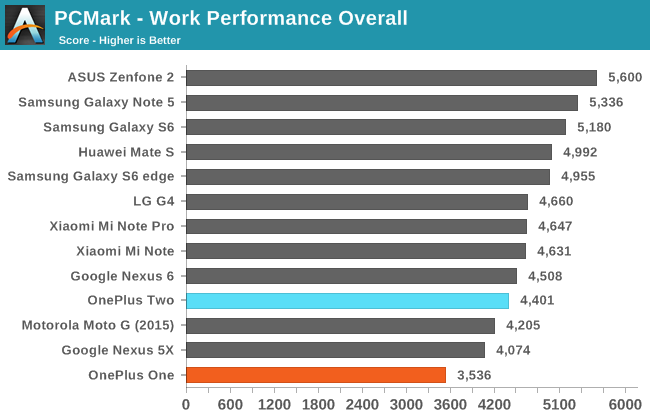
In PCMark the OnePlus 2 again does better in the web tests due to the fact that the A57 cores actually switch on, but falls behind in the photo editing test and even more so in the writing test. The writing test is actually a fairly good indicator of CPU performance, because it involves decompressing text files, moving text from one file to another, adding text and images, and then saving them to disk. During that entire period the A57 cores are not triggered at all, which contributes to the low score. Even with that, it's not exactly clear to me what additional factors make the Snapdragon 808 and 810 devices all perform so poorly here compared to a device like the Moto G which just has 4 Cortex A53 cores. It could very well be the result of issues with ART, or other problems with frequency scaling on the A53 cluster. In any case, like all Snapdragon 808 and 810 devices, the OnePlus 2 struggles in the aspects of the test that heavily tax the CPU.
The issues with Snapdragon 808 and 810 have led to many issues with CPU performance this year across a number of Android phones. However, OnePlus is the only company I can remember publicly stating that they had worked to overcome these issues, and the fact that the OnePlus 2 falls so far behind other 808 and 810 devices in the web browsing puts a lot of doubt in the validity of those remarks. It's pretty safe to say that if you care about CPU performance you're much better off with the OnePlus One or OnePlus X, both of which use Snapdragon 801, and if you're thinking about buying the OnePlus 2 you really need to take the performance issues into consideration because they're on a different scale than those on other recent smartphones. At $400 there's a lot of competition, and the CPU and JavaScript performance on the OnePlus 2 just doesn't measure up.










132 Comments
View All Comments
Allan_Hundeboll - Wednesday, December 16, 2015 - link
Some info in this review is wrong. OnePlus One do not have OIS but it does have a metal frame.jabber - Wednesday, December 16, 2015 - link
I was going to get the One Plus 2 but waited so long for an invite I just gave up and went on Amazon and bought a LG G4.The invite appeared the next day. I kind of thought it would. Too late guys. You lost a sale.
I do not regret getting the G4. Great phone.
gg555 - Sunday, December 20, 2015 - link
This review demonstrates everything that I've always thought about OnePlus. It's all hype over substance.They do not make flagship phones (let alone flagship killers). They put a couple high end features in the phone, cut corners in many other places, try to distract and dazzle you with the high end features, and then sell you essentially a mid-range phone at a mid-range price, which is exactly what you should expect for the money.
They also have engineering issues and not so great quality control. How they can have taken the already hobbled Snapdragon 810 and reduced it's performance even more, to the level of a budget phone like a Moto E (as the review says) is beyond comprehension. But still, they made a whole big promise about how they'd handled the 810s heat issues. Handled it by making the chipset worse than far inferior chipsets.
If this is your budget range, you're far better off with a Moto X, which is a truly nice phone.
p51d007 - Tuesday, December 22, 2015 - link
Not to mention out right LIES."First to have a USB-C port"....yeah, the plug & jack are "USB-C" like, but the PORT itself is still USB-2. No support, buggy software, ghost touches.
The X is a MUCH better phone. If you really really have your heart set on the 2 (personally, I'd pass), wait a few months for them to eventually work out the bugs. The OnePlus One is now not really a bad phone, but it took them nearly a year to get most of the bugs out.
OnePlus, is nothing but the beta tester for Oppo. Every OnePlus phone, has a Oppo version that comes out later. The Oppo Find9, was SUPPOSE to be out at the end of this year, but feedback from the suckers who bought the OnePlus2, about the glitches with the overheating/underclocking, they've DELAYED the Find9 until next year and it will come out with the SD820 chip, NOT the 810 chip.
UtilityMax - Saturday, December 26, 2015 - link
I have OPO since February, and it had been running pretty smooth. Fantastic smartphone for the money. Even today, it sort of makes sense given the price dropped $50 to $300 for 64GB version. One amazing thing about it is not just the great screen, camera and battery life, but also the reception. I must be living in an area with a sh1tty LTE coverage since all of our other smartphones work barely faster than 3GB (including iPhones), but the OPO, zOMG! The signal is like 10dbm better at all times, which results in very nice data benchmarks often slaughtering the broadband connection I have (used to be 20Mbps, now 40Mbps with Oneplus One getting that much over LTE)UtilityMax - Saturday, December 26, 2015 - link
I'd disagree with your comment. Both the OnePlus One and OnePlus X were a home run, but with a few small reservations. OnePlus One was well rounded and was at least 90% as good as any flagship phone, but sold for about half the typical price. Even today the 64GB Oneplus One probably remains the best $300 (with a few reservations, such as the store shows they're out of stock). And Oneplus X is basically a Oneplus One, but in a form factor and build quality that really should have been in Oneplus Two, and at $250 in the US, again it's one of the best phone for that price. The Oneplus Two may have its issues, but guess what.. all of the current crop of Android phones using Snapdragon 64-bit 808/810 SoCs have those issues.Ashwith - Friday, December 25, 2015 - link
Seems like the reviewer does not have much experience in reviewing nor regarding smartphone. These days we get to see reviewers dime a dozen and sadly most of them sucks like this one. There is no phone which is perfect and oneplus 2 has its list of cons which are many. But for the prize of $389/- it will give a stiff challenge to all other phones in that range. Only when you use 5X you will get to see that it does not stand a chance with Oneplus 2 and along with goes the credibility of this reviewer. S6 on the other hand does better in all departments. Cheers!UtilityMax - Saturday, December 26, 2015 - link
One great alternative is still the old good Oneplus One. Sold for 250/300 for the 16GB/64GB version respectively. Even today, it's still probably the best $300 smartphone, which is a testament to how well it was made. The only issue though is that it's out of stock at oneplus store...blzd - Friday, January 1, 2016 - link
Your experience reviewing and regarding smartphones is clearly inferior to that of the reviewers. Maybe one day you'll review a smartphone and not just try and justify your purchase decisions. Cheers!Cloudane - Sunday, January 31, 2016 - link
Yikes... what a slating. I just ordered one of these having seen other reviews and thinking they were good, starting to wonder about cancelling my order now :(